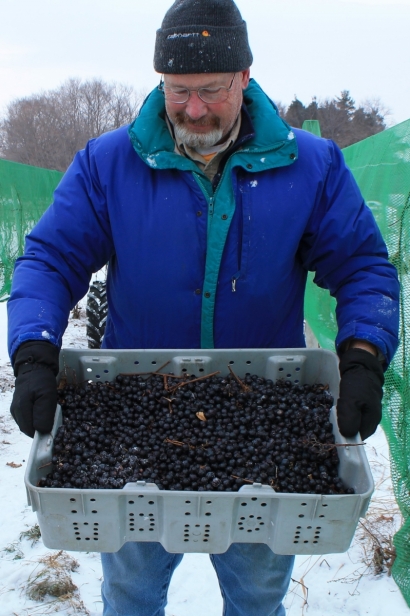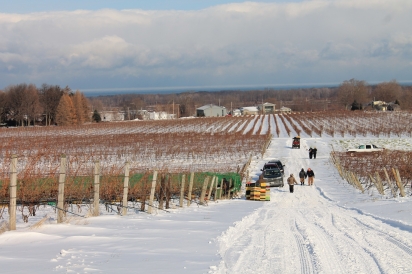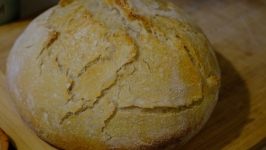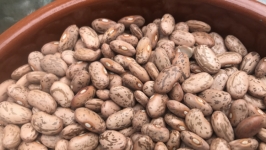Ice Wine: How sweet it is
Ice wine—that sweet liquid libation, the perfect dessert wine to enjoy after an evening of dining, is oh so pricey, but oh so delicious! What exactly is ice wine, how is it made, and most importantly, why is it so much more expensive than regular wine?
By definition, ice wine can only be made from grapes that have ripened and frozen naturally on the vine. While any variety of grapes can be used, those that ripen later in the season, such as Vidal Blanc and Riesling, are a better choice.
In the fall, grapes that will be used for ice wine are covered with netting to protect them from birds. Once the grapes are completely frozen, usually in December or January, they are manually harvested and pressed.
Ice wine harvest requires many hands, sort of like an Amish barn raising. Winery farm workers are joined by family, friends, and other interested parties to help out. Stephanie Schuckers Burdo, publisher of Edible Western NY, helped with the harvest last season. “We started picking early in the morning on a bitter cold day in December; it was 15 degrees,” Burdo told me. “We had to stop around 10 a.m., when the sun started to warm up the grapes. I think the temperature had reached 17 degrees.”
Ice wine tends to be more expensive than regular wines, since in addition to the hand-picking required, you get only about one-fourth the wine that you’d yield if you had harvested those grapes before they froze.
“The grapes are frozen as solid as a glass marble,” said Jennifer Johnson from Johnson Estate Winery in Westfield. “The elixir of the grapes is what is pressed out.” Only a drop or two are extracted from each grape, resulting in a very sweet wine, with a sweetness level of 18-20 percent depending on the vintage.
ICE WINE HISTORY
Some believe that frozen grapes were used in winemaking in Roman times. While that can’t be known for sure, we do know that in the 18th and 19th centuries, ice wine, or Eiswein in German, was produced in Germany on a limited basis when weather conditions allowed. In modern times Germany has more consistently been able to produce ice wine due to advances in technology and better equipment.
As for North America, in nearby Niagara-on-the-Lake, Hillebrand was one of the first commercial ice wine producers in Canada and Inniskillin Winery had one of the first ice wines in Canada to win a major international award. Pillitteri Estates, also in Niagara-on-the-Lake, is one of the largest estate ice wine producers in the world.
WESTERN NEW YORK ICE WINES
The climate in Western New York is also conducive to ice wine, with a half-dozen wineries on the Niagara Wine Trail in Niagara, Orleans and Monroe counties producing it. Another half-dozen or so wineries on the Lake Erie Wine Country Trail, along Lake Erie in Chautauqua County and Erie County, Pennsylvania, also produce ice wine.
“Johnson Estate Winery, on the Lake Erie Wine Country Trail, has been producing true ice wines, made with grapes frozen on the vine, for over 20 years,” said Jennifer Johnson, who runs the winery with her husband, Fred. They make their ice wine from Vidal Blanc and Chambourcin grapes.
“We make a third, very rare sparking rosé ice wine using the method champenoise,” she added. Johnson Estate was the first winery in North America to use this method to produce a sparking ice wine in a bottle, as opposed to in a tank, as other wineries have done. It involves dousing each bottle with yeast to make bubbles, then removing the yeast once the bubbles form.
Johnson also noted that according to their winemaker, Jeff Murphy, a good ice wine has to have a good acid/sweetness balance. Without the acid, a sweet wine would become too sweet, like drinking maple syrup.
On the Niagara Wine Trail, Schulze Vineyards and Winery first produced a Vidal Blanc ice wine in 2008 and added a Block Three (Catawba) in 2010.
“My husband, Martin, is German and he immigrated to the United States with his parents in 1966,” said Ann Schulze. “They bought their farm in 1969 with just the Niagara grapes and have planted other varieties over the years.”
Martin dreamed of starting a winery; he and Ann worked toward that goal and opened the winery in 2007.
“His passion for ice wine and sparkling wines comes from his heritage of growing up in Germany,” added Schulze.
Jonathan Oakes, winemaker for Leonard Oakes Winery, as well as for Schulze Vineyards, started producing ice wines in 2008; that vintage won double gold.
“I studied in Canada, one of the birthplaces of fine ice wine,” said Oakes. “Our terroir is virtually the same as theirs, as we are both considered the Niagara region, just on opposite sides of the river.”
He continued, “[Ice wine] is a natural fit for us because our climate provides the opportunity for a reliably consistent cold that is low enough to freeze the water content inside the berry, but not too cold to cause damage to the vine. We produce it in the traditional method whereby the grapes are frozen on the vine and then harvested by hand once the temperature has dropped to 13–15 degrees for a minimum of four hours.”
ICE WINE AND FOOD PAIRINGS
Of course, you can sip ice wine by itself, as you would any dessert wine. However, to enhance your tasting experience, you might try pairing ice wine with food.
“Over the years, I've realized that it is okay to let the ice wine be the star of the show, said Jennifer Johnson. “That is, if it is to be served in or with a dessert course, the food pairing is preferably not as sweet at the ice wine. As with pairings for other types of wines, the choices can be driven by what contrasts or complements the particular vintage of ice wine. We've discovered through tasting trials that the raisin and berry notes of the Chambourcin are much complemented by chocolate, walnuts, or cinnamon—in any combination. Vidal Blanc has honey/peach notes and is pleasing with desserts with ‘pumpkin’ spices or vanilla and lemon.”
She noted that some of the most enjoyable desserts using ice wine have been ones created spontaneously, put together when guests arrive and no dessert is prepared. One of her suggestions is Vidal Blanc ice wine paired with lightly toasted crostini topped with goat cheese and slices of pears or peaches—or even honey, if fruit is not available.
Jonathan Oakes’ personal favorite ice wine/food pairing consists of either foie gras or terrine on a crostini with a very aromatic bleu cheese, topped with a drizzle of honey or a dab of marmalade or membrillo (a paste made with quince).
Ann Schulze shared one of her favorite recipes using ice wine: a holiday ham recipe developed by her son, Tyler Finley. With an injector, infuse a ham with half a bottle of ice wine. Follow the time and temperature suggested for baking the size and type of ham you have. Pour the other half of the wine into a saucepan and add a quart of raspberries, some lime juice, and a little jam. Simmer. Pour over the ham for the last half hour it bakes.
ICE WINE FESTIVALS
While neither the Niagara Wine Trail nor the Lake Erie Wine Country Trail have ice wine festivals planned for this year, there are two festivals this winter only a short drive from Western New York, one just over the border in the Niagara region of Ontario, the other in the Rochester area.
Enjoy three weekends of ice wine tastings, including a special Ice Wine Gala, featuring fine dining and over 100 different ice wines at the Niagara Ice Wine Festival in mid-January. There will also be outdoor activities along the wine trail, including an ice wine village set up along Queen Street in historic old town Niagara-on-the-Lake.
The New York Ice Wine and Culinary Festival will take place in February at Casa Larga Vineyards in Fairport, just east of Rochester. One can sample a variety of ice wines, enjoy an ice wine infused tasting menu, take a wagon ride through the vineyard, go on a winery tour, and listen to musical entertainment.
Johnson Estate Winery: 8419 US 20 West, Westfield; 800-374-6569
Schulze Vineyards and Winery: 2090 Coomer Rd, Burt; 716-778-8090
Leonard Oakes Estate Winery: 10609 Ridge Rd, Medina; 585-318-4418
Casa Larga Vineyards: 2287 Turk Hill Road, Fairport; 585-223-4210













